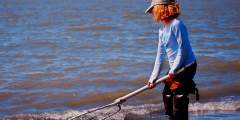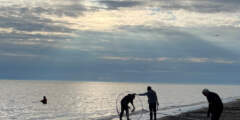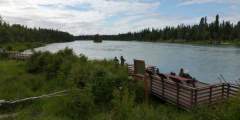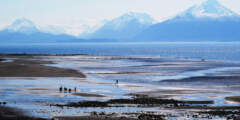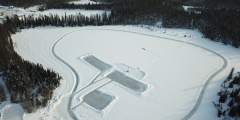The Best Fishing Spots in the Kenai & Soldotna Areas
This is a list of the most popular fishing spots near the towns of Kenai and Soldotna. Most anglers in the area are fishing the Kenai River during the summer salmon runs, but this area is also dotted with sparkling lakes within the Kenai National Wildlife Refuge where anglers can catch rainbow trout and dolly varden.
Looking For a Guide?
If you're visiting Kenai or Soldotna and are looking to fish these world-famous rivers, consider a guided charter. These locals companies know where to go, provide all the gear, and will assist with processing and shipping your catch home. See our list of recommended charter companies in the area.
Show Map
Fishing Spots
Kenai River Access Points
Each head of household is allowed to keep 25 sockeye salmon per year, and every additional member of the family is entitled to 10 fish.
One of the most popular areas in the state for dipnetters to fish the Kenai River in the month of July. There’s a large paved parking area, and camping is allowed July 10 — 31 during the sockeye salmon run. Restrooms available.
Large parking area for over 200 vehicles and 4 boat ramps. Not a shore fishing area.
Located down Beaver Loop Road, just outside of Kenai, Cunningham Park is a great, easy-access location for sockeye and silver salmon. The shoreline here is a mix of gravel and mud, with the mud being more prevalent below the tidal zone. That said, this spot is very tidal dependent, so you’ll have to continually adjust your bait setup as the water rises or falls.
Wading access and boat launch. Gravel parking area and boat launch are both available for a fee. Check website for current rates. This is a smaller parking area than some nearby access points for the Kenai River. Depending on the season can fish for rainbow trout, dolly varden, salmon (King, Sockeye, Coho). Check the ADF&G website for regulations.
Popular location to fish the Kenai River from a raised platform along the water and to launch boats. Large parking area and boat launch are both available for a fee. Check website for current rates. Vault toilets. Depending on the season can fish for rainbow trout, dolly varden, salmon (King, Sockeye, Coho). Check the ADF&G website for regulations.
The most popular campground in Soldotna with over 250 campsites in a large wooded area. And, it’s a fisherman’s dream for accessing the bounty of the Kenai River. There are twenty-five sets of stairs to the river, 2 fishing platforms that are 85 feet long (one is accessible), and 650 feet of elevated boardwalk.
Soldotna Park, in downtown Soldotna, offers all Kenai River species — but most people are here for the sockeye. That means it can get crowded during peak sockeye season, but it’s also a good place to learn how to fish for sockeye. The combination of easy accessibility, hard-packed gravel and a shallow grade make the fishing enjoyable.
This spot is particularly good for anyone who’s mobility impaired, since you access the river by a flat, metal boardwalk — and the actual fishing area is also from the boardwalk. This makes Moose Meadows one of a very few places where anglers can fish for sockeye without having to be in the water — you can do excellent even from a wheel chair.
This spot in Sterling — at milepost 82.3 at the Isaak Walton Campground — is where the Moose River meets the Kenai River, and the two rivers’ differing paces are drastic. The Moose River is very slow and wide, with almost no current — so much so that it feels more like a lake. The Kenai River, on the other hand, flows fairly swiftly in comparison, and the confluence can play strange tricks on your tackle.
Access point to fish the Kenai River between the Russian River and Skilak Lake. Species found here include trout, dolly varden, and salmon (kings, sockeye, and silvers — depending on time of year). There is a gravel parking area and a boat launch point. Check with Alaska Department of Fish and Game for regulations and limits.
Other Fishing Spots in the Kenai / Soldotna Area
The trail is half a mile long and takes you through a mature birch forest that is carpeted with devil’s club and watermelon berry plants. It’s an easy walking, ideal for small children, and ends at a small camping area on a slight bluff that overlooks Bishop’s Beach and Bishop Creek.
The Stormy Lake boat launch and day use area is located within the Captain Cook State Recreation Area. Anglers can fish for rainbow trout and Arctic Char in Stormy Lake. There’s a picnic shelter, water, and toilets available on site.
Swanson River Campground, in the Kenai National Wildlife Refuge near Sterling, offers 3 wooded sites along the Swanson River off Swanson River Road. Managed by the U.S. Fish and Wildlife Service, it features vault toilets, a boat launch, and river access. This quiet, primitive spot is ideal for fishing rainbow trout, Dolly Varden, or silver salmon, paddling, and enjoying the wilderness.
Dolly Varden Lake Campground, in the Kenai National Wildlife Refuge near Sterling, offers 12 wooded sites with lake access off Swanson River Road. Managed by the U.S. Fish and Wildlife Service, it features vault toilets, a boat ramp, and a quiet, primitive setting. Campers can fish for Dolly Varden and rainbow trout, paddle the lake, or enjoy the refuge’s serene wilderness near Sterling.
Fish Lake Campground, along Swan Lake Road in the Kenai National Wildlife Refuge near Sterling, offers 2 wooded sites by Fish Lake. Managed by the U.S. Fish and Wildlife Service, it features lake access, a vault toilet, and fire rings for a minimalist stay. This quiet roadside retreat is perfect for fishing stocked Arctic char, paddling, or enjoying the refuge’s solitude, with Sterling nearby.
During the summer months it’s a great spot for canoeing, kayaking, paddle boarding, even paddleboard yoga. The colder months are just as lively as the warmer ones. There’s a skating loop on the lake’s perimeter, as well as several skating areas on the lake. The City offers free public skates Saturday afternoons, ice conditions dependent, December through February.
Popular lake due to its close proximity to Soldotna to fish for rainbow trout and coho salmon. There’s also a boat launch, and on sunny summer days locals will be kayaking, boating, jet skiing, and tubing. There’s a paved parking area.
Day use area for fishing (stocked rainbow trout and coho) and trail access, with picnic shelter and toilets. Access is just off the Sterling Highway and W Scout Lake Loop Road.
Kelly Lake Campground, in the Kenai National Wildlife Refuge near Sterling, offers 4 open sites along the lake in a quiet roadside setting. Managed by the U.S. Fish and Wildlife Service, it features fire rings, lake access, and a simple, primitive atmosphere. Campers can fish for trout, paddle a kayak or canoe, and enjoy the peaceful solitude of the refuge, with Sterling close by.
Engineer Lake Campground, along Skilak Lake Road near Sterling, offers 3 wooded sites on quiet Engineer Lake shores. Managed by the U.S. Fish and Wildlife Service, it features vault toilets, fire pits, and lake access for a primitive stay. This secluded retreat is ideal for fishing Dolly Varden and landlocked salmon, paddling, and enjoying wilderness, with Sterling nearby.
Camp out at this quiet, clearwater lake, along Skilak Lake Road in the Kenai National Wildlife Refuge, where glaciers once stood over 2,000 feet tall. There’s opportunities for fishing (and a boat launch) and a picnic area along the shore. All campsites are available on a first-come, first served basis.

